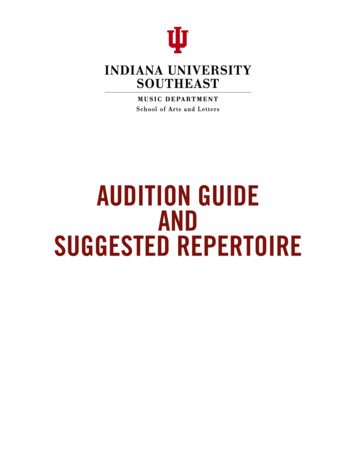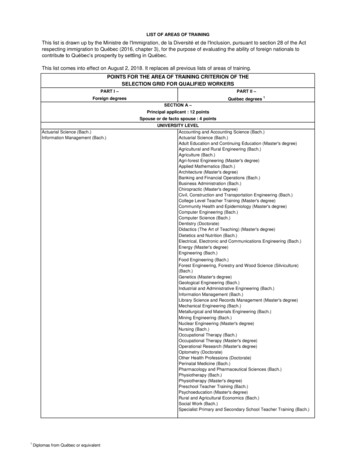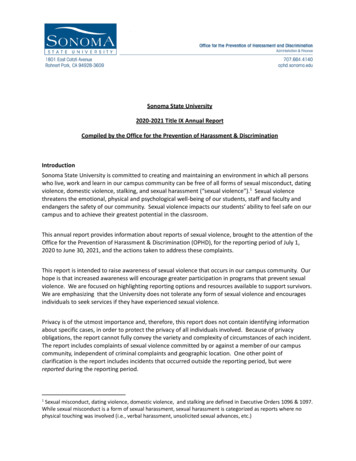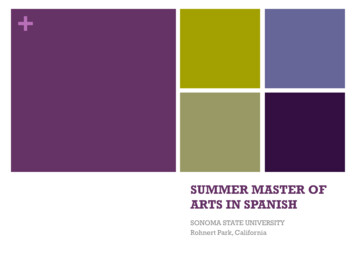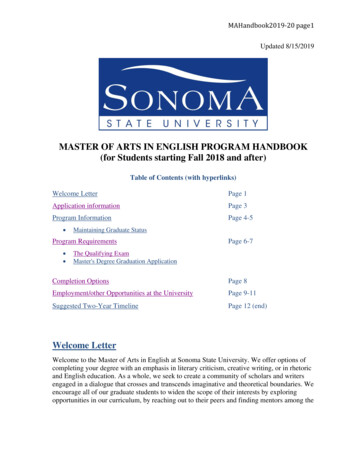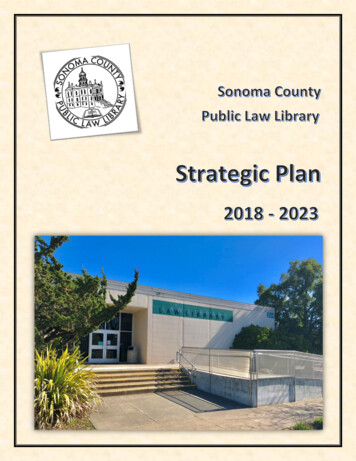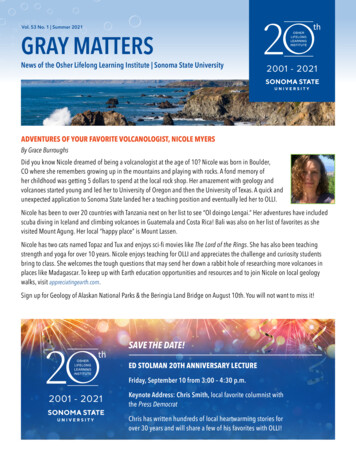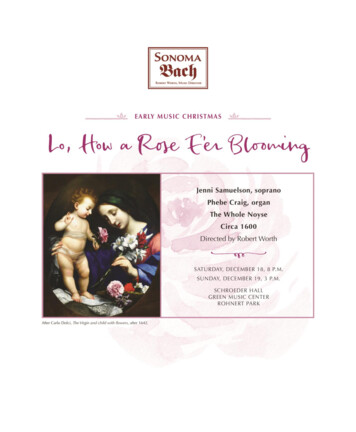
Transcription
Sonoma Bach’s 2021-2022 SeasonNever to allow gradually the traffic to smotherwith noise and fog The Flowering of the Spirit.—Stephen SpenderFor traffic, read pandemic; for noise and fog, read fear and bad news. Most of us lost ourcenters for a time, and there certainly seemed to be very little flowering of the spirit going on.Even now, things seem choppy, and where is the elbowroom, the bandwidth, the poeticimpulse, so that the spirit might open up?And yet we need it now more than ever. Those of us who are able to achieve, to experience,to act upon any measure of such flowering will be helping ourselves, our loved ones, even theworld. But we need to think about how to proceed in the face of what is still such uncertainty,such peril.One idea is to carve out space, time, opportunity for rest and recreation, for friendship andcommunity, for refreshment and inspiration. These things can help create the conditions inwhich our spirits might revive.Another idea is to recognize silver linings: What has been good about this difficult period foryou? For me, it has been wonderful to visit with my far-flung family every two weeks, muchmore often than usual. My writing has improved as it has become my primary way ofcommunicating with our Sonoma Bach community. And I’ve become a much better cook.Nature can help. Just a little calm time in the woods can do wonders. Admiring a flower or abird or a gorgeous sunset can create inroads or access points.And for most of us—certainly for you, since you’re reading this—the arts can provide a liftwhen we’re flagging. Have you heard some good music lately? Read a really inspiring book?Sung a song? Danced at all? These things can minister to our needs, as they speak to us in thelanguage of our spirits.And that’s where Sonoma Bach comes in. Sequestered away so long from our beloved spirittending activity of making music together, we are so ready to roll. Safely and sensibly, ofcourse. But we’re just itching to dig in, to learn music, to hone it to the best of our abilities, tomake it really musical, and then to share it with you, in hopes that it will lift your spirits as itdoes ours.We’ve built our 2021-2022 season, The Flowering of the Spirit, around music that we love,music that has the potential to revive and nurture and heal. We’ve put all this music togetherinto eight programs, each designed to explore and address its own corner of what we’ve beenthrough, what we need now, what we can be. We’ll be remembering together, mourningtogether, rejoicing together, looking forward together. Come and join in!
Presented by Sonoma Bach in association with the Green Music CenterEarly Music ChristmasLo, How a Rose e’er BloomingFEATURINGJenni Samuelson, sopranoPhebe Craig, organThe Whole NoyseCirca 1600Directed by Robert WorthSaturday, December 18, 2021, 8 p.m.Schroeder Hall, Green Music CenterSonoma State UniversitySunday, December 19, 2021, 3 p.m.Schroeder Hall, Green Music CenterSonoma State University
Lo, How a Rose E’er BloomingToday, shepherds rejoice,And angels doNo more: Thy voiceCan reach that too:Bring them at least thy pipe along,And mingle consort with the angels’ song.—CLEMENT PAMAN, from On Christmas Day to My HeartThe New Oxford Book of Carols, published nearly 30 years ago, is a magisterial collection ofsongs for Christmas, with settings of both beloved and lesser-known carols from throughoutEurope and around the world, all wrapped up with a bow of top-notch scholarship andilluminating commentary. Circa 1600, joined by brass, organ and Jenni Samuelson, our wonderfulsoprano soloist, presents a bouquet of songs from the NOBC in settings from spare tomagnificent. Our program includes arrangements—by both ancient and modern composers—ofpieces drawn from the various types and epochs of the carol.Welcome to the third concert production of our season! We’re so delighted to be able to performfor you a whole lot of our favorite Christmas music; and we’re especially excited to be back herein our beloved Schroeder Hall for the first time since February, 2020.In our Early Music Christmases over the years, we have taken many tacks—we’ve told the tale invarious ways; we’ve concentrated on the music of a single country; we’ve structured our showaround a single beloved Christmas song; we’ve mixed early music with the more modern variety.But we’ve never really focused upon Christmas Carols.Well, this year, in our tenth annual EMC, we’re making up for that. As noted above, each piece inour program is based upon a song in the New Oxford Book of Carols. The collection is reallymarvelous! It includes hundreds of songs, and unlike many of its forebears, presents lots of carolsin languages other than English and from countries other than Great Britain or the USA.And what a musical feast it is! You’ll hear happy party music, tales from the Bible, tender scenesand bright celebrations, songs in German, Latin, English, Spanish and more. Each of our carols isto be found in the NOBC, but we’ve scoured the countryside (and the internet and the musiclibraries) for the best arrangements of these tunes, from composers such as Gilles Binchois (14001460), Michael Praetorius (1571-1621), Andreas Hammerschmidt (c1611-1675), all the way up toPhilip Lawson (born 1957).We’ll use an array of voicings and orchestrations to perform this repertoire, ranging from acappella choir numbers to soprano solos with organ to brass instrumentals to everythingincluding-the-kitchen-sink. But there’s one additional component we need: YOU! After our longenforced layoff from group singing, we invite you to join us for the last carol in each of our six
sets. You’ll find the melodies interleaved with the lyrics in our ‘Notes, Texts and Translations’section a little further on in this program. Even through masks your voices will blend with oursand with those of others to create a joyful sound to usher in this festive season!Each set is structured for variety and contrast, containing a festive opening song; a soprano solo;a larger-scale work for the full ensemble; a brass feature; and, of course, that closing carol. You’llfind notes about the music in each of these sets further along in the program.But the main thing is to sit back and revel in the music of the season!Thank you so much for coming to our concert. We very much hope you enjoy yourself, and thatyou leave with these delightful melodies running round your brain. We wish you a very merryholiday season, and we look forward to welcoming you back here in Schroeder for our JanuaryOrgan Recital—‘The Incomparable Herr Buxtehude’—featuring Anne Laver, Dianna Morgan,Christopher Fritzsche and the Sonoma Bach Choir.Full details on our spring concerts are available on sonomabach.org.Robert Worth, Music DirectorNativity from Babstche Gesangbuch, 1545
ProgramSet OneA solis ortus cardine. Gilles Binchois (c1400-1460)Nun komm der Heiden Heiland . Michael Altenburg (1584-1640)Veni, veni Emmanuel. Traditional, arr. Philip Lawson (b1957)Corde natus ex parentis . Aurelius Prudentius Clemens (348-c413)What child is this? . Traditional, arr. John Stainer (1840-1901)Set TwoE la don, don, Verges Maria . Anonymous, from Cancionero de Uppsala (1556)Swete was the song . Anonymous 16th-c. tune, arr. Thomas Hammond (d1662)Puer natus in Bethlehem (from Musae Sionae II) . Michael Praetorius (1571-1621)Instrumental: Der Tag, der ist so freudenreich. Traditional, arr. J.H. Schein (1586-1630)and L. Schröter (c1530-c1601)God rest ye merry gentlemen . Traditional, arr. David Willcocks (1919-2015)Set ThreeEn natus est Emmanuel . Michael Praetorius (1571-1621)Instrumental: In dulci jubilo .Leonhard Paminger (1495-1567)Wie schöne leucht’t der Morgenstern . Johann Crüger (1598-1662)Maria durch ein Dornwald ging . Traditional, arr. Siegfried Strohbach (1929-2019)O come, all ye faithful. Latin Hymn, arr. J. Reading (1692)INTERMISSION
Set FourMagnum nomen Domini . Bartłomiej Pękiel (c1601-1670)O Jesulein süss! O Jesulein mild! . Traditional 17th-century, arr. Samuel Scheidt (1587-1654)and J.S. Bach (1685-1750)Vom Himmel hoch, da komm ich her . Martin Luther, arranged by J.H. Schein (1586-1630)and M. Praetorius (1571-1621)Instrumental: Es ist ein Ros entsprungen .arr. Michael Praetorius (1571-1621)and Hugo Distler (1908-1942)Joy to the world . Traditional, arr. David Willcocks (1919-2015)Set FiveThe holly and the ivy . Traditional, arr. Alice Parker (b1925)Instrumental: Hosiana in der Höhe . Michael Praetorius (1571-1621)Riu, riu chiu . Mateo Flecha the Elder (1481-1553)In the bleak mid-winter . Harold Darke (1888-1976)The first Noël . Traditional, arr. John Stainer (1840-1901)Set SixThe angel Gabriel . Traditional, arr. Edgar Pettman (1866-1943)Instrumental: Machet die Tore weit .Andreas Hammerschmidt (c1611-1675)Wassail Song. Ralph Vaughan Williams (1872-1958)Vom Himmel hoch, O Engel kommt! . Anonymous, 1623, arr. David Willcocks (1919-2015)Angels we have heard on high .Traditional, arr. Edward Shippen Barnes (1887-1958)Closing SongResonet in laudibus (from Eulogodia) . Michael Praetorius (1571-1621)
Notes, Texts and TranslationsSet OneWe begin with an ancient chant, followed by a 4-part setting of the same by Gilles Binchois. Fastforwarding a couple of hundred years, we feature Martin Luther’s great Advent hymn, ‘Nunkomm der Heiden Hailand’, in a concerto-like arrangement. Philip Lawson’s remarkable settingof ‘Veni Emmanuel’ completes our Advent triptych. Prudentius’ nativity chant takes us all theway back to the 5th-century; and we close with the song Greensleeves, transmogrified into thebeloved carol ‘What child is this?’ We warmly invite you to sing with us on this song, and oneach of the songs which close our sets!A solis ortus cardine. Gilles Binchois (c1400-1460)A solis ortus cardine,Ad usque terrae limitem,Christum canamus principem,Natum Maria virgine.From the pivot of the sun's risingTo the farthest edge of the earthLet us sing to Christ our Lord,Born of the Virgin Mary.Nun komm der Heiden Heiland . Michael Altenburg (1584-1640)Nun komm, der Heiden Heiland,Der Jungfrauen Kind erkannt!Daß sich wunder alle Welt,Gott solch' Geburt ihm bestellt.Now come, savior of the gentiles,Known as the Virgin's child!Over whom the whole world marvels,That God had ordained such a birth for Him.Er ging aus der Kammer sein,Dem kön'glichen Saal so rein,Gott von Art und Mensch ein Held,Sein'n Weg er zu laufen eilt.He went forth from his chamber,From the royal palace so pure,By nature God and man, a hero,He hastens to run his way.Sein Lauf kam vom Vater herUnd kehrt' wieder zum Vater,Fuhr hinunter zu der Höll'Und wieder zu Gottes Stuhl.His course came from the FatherAnd leads back to the Father,He went down to HellAnd back to God’s throne.Veni, veni Emmanuel . Traditional, arr. Philip Lawson (b1957)Veni, veni Emmanuel!Captivum solve Israel!Qui gemit in exilio,Privatus Dei Filio,Refrain: Gaude, gaude, Emmanuelnascetur pro te, Israel.Come, come, Emmanuel;Free captive IsraelWho mourns in exileDeprived of the Son of God.Refrain: Rejoice, rejoice, EmmanuelIs born for you, Israel.
Veni o Jesse virgula!Ex hostis tuos ungula,De spectu tuos tartariEduc, et antro barathri.RefrainCome, O Shoot of Jesse;From the talons of Your enemy,From the pit of hellAnd the hollow abyss deliver us.RefrainVeni, veni o oriens!Solare nos adveniens,Noctis depelle nebulas,Dirasque noctis tenebras.RefrainCome, come, O Rising Sun,Shine on us by Your coming;Dispel the fog of nightAnd drive away the shadows of death.RefrainVeni clavis Davidica!Regna reclude coelica,Fac iter tutum superum,Et claude vias inferum.RefrainCome, Key of David,Unlock the kingdom of heaven;Make safe the path to the things aboveAnd close the way to hell.RefrainCorde natus ex parentis . Aurelius Prudentius Clemens (348-c413)Corde natus ex parentisAnte mundi exordium,Alpha et Omega vocatus,ipse fons et clausulaOmnium quae sunt, fuerunt,quaeque post futura sunt.Saeculorum saeculis.Begotten of the Father’s loveBefore the world began,He is called Alpha and Omega,He is the source, and the endingOf all that is, that has been,And that will be in the future,Evermore and evermore!O beatus ortus ille,Virgo cum puerpera,Edidit nostram salutem,Feta Sancto Spiritu,Et puer redemptor orbisOs sacratum protulit,Saeculorum saeculis.O that blessed birth,When the virgin, with child,bore our salvation,By virtue of the Holy Spirit;And the child, redeemer of the world,Revealed His holy face,Evermore and evermore!Gloriam Patris melodisPersonemus vocibus;Gloriam Christo canamus,Matre nato virgine,Inclitoque sempiternamGloriam Paraclito.Saeculorum saeculis.Let us raise song to the father’s gloryWith our own voices;Let us sing of the glory to Christ,Born of the virgin mother,To the glorious advocate as wellBe praise given.Evermore and evermore.
What child is this? . Traditional, arr. John Stainer (1840-1901)1. What Child is this who, laid to restOn Mary's lap is sleeping?Whom Angels greet with anthems sweet,While shepherds watch are keeping?2. So bring Him incense, gold and myrrh,Come peasant, king to own Him;The King of kings salvation brings,Let loving hearts enthrone Him.This, this is Christ the King,Whom shepherds guard and Angels sing;Haste, haste, to bring Him laud,The Babe, the Son of Mary.Raise, raise the song on high,The Virgin sings her lullaby.Joy, joy for Christ is born,The Babe, the Son of Mary.Set TwoFrom a Spanish print, the sole exemplar of which ended up in Sweden, we offer the rousing ‘E ladon don’, with its dancing refrain. ‘Swete was the song’, one of many ancient English nativitysongs, portrays a tender scene between virgin and child. ‘Puer natus in Bethlehem’ is one ofMichael Praetorius’ many settings of the simple old tune; here he treats us to a tour de forcefeaturing many verses in two languages, wrapped in a festive 8-part texture. Our instrumental forthis set features two German settings of a venerable chant, ‘Dies est laetitiae’; and we close withthe rousing ‘God rest ye merry gentlemen’, which dates back to the mid-17th-century. Don’t beshy: Raise your voice on high!E la don, don, Verges Maria . Anonymous, from Cancionero de Uppsala (1556)Refrain: E la don don, Verges Maria,E la don don; peu cap desanqueQue nos dansaron.Refrain: She is our Lady, our Lady, the VirginMary. She is our Lady; on pale feetthe angels danced for us.
1. O garçons a questa nitUna verges n'a parit,Un filio qu'es tro polit,Que non au tan en lo mon.RefrainO lads! On this nighta virgin gave birthto a fine boywithout equal in this world.Refrain2. Digas nos qui te l'a dit,Que Verges n'a ya parit,Que nos may avem ausitLo que tu diu giràn ton.RefrainSay who told you so,That a virgin gave birth,For we've never heardSuch a thing as you say.Refrain3. A eo dian los argeus,Que cantavan alta veusLa grolla n'ecelsis Deus,Qu'en Belén lo trobaron.RefrainThe angels said it,Singing in loud voicesGloria in excelis Deus,He is to be found in Bethlehem.RefrainSwete was the song . Anonymous 16th-c. tune, arr. Thomas Hammond (d1662)Swete was the song the Virgin sang,When she to Bethlem Juda came,And was deliver'd of her Son,Who blessed Jesus hath to name.Lulla, lulla, lullaby,Lulla, lulla, lullaby,Sweet Babe, sang she,My Son, and eke my Saviour born,Who hast vouchsafed from on highTo visit us that were forlorn;Lalula, lalula, lalulaby, sweet babe, sang she,And rocked Him featly on her knee.Puer natus in Bethlehem (from Musae Sionae II) . Michael Praetorius (1571-1621)Puer natus in Bethlehem,Unde gaudet Jerusalem.Alleluia!A boy is born in Bethlehem,For this rejoice, Jerusalem.Alleluia!Ein Kind geborn zu Bethlehem,Des freuet sich Jerusalem.Alleluia!A boy is born in Bethlehem,For this rejoice, Jerusalem.Alleluia!Hier liegtes in dem Krippelein,Ohn’ Ende ist die Herrschaft sein.Alleluia!Here lies in the little crib,The one whose kingdom is without end.Alleluia!Das Öchselein und das EseleinErkannten Gott, den Herren sein.Alleluia!The little ox and the little donkeyRecognized him to be the Lord.Alleluia!
Die König aus Saba kamen dar,Gold, Weihrauch, Myrrhen brachten sie dar.Alleluia!The kings from the east came there,Gold, frankincense and myrrh they brought.Alleluia!Sein Mutter ist das reine Magd,Die ohn’ ein Mann geboren hat.Alleluia.His mother is a pure maiden,Who without a man has given birth.Alleluia!Die Schlang ihn nicht vergiften konnt,Ist worden unser Blut ohn Sünd.Alleluia!The serpent could not poison him,Our blood has become without sin.Alleluia!Er ist uns gar gleich nach dem Fleisch,Der Sünden nach ist er uns nicht gleich.Alleluia!He is just like us in the flesh,But he is not like us as to committing sin.Alleluia!Damit er uns ihm machet gleich,Und wiederbrächt zu Gottes Reich.Alleluia!Thus he can make us equal to him,And then return to God’s kingdom.Alleluia!In hoc natali gaudio,Benedicamus Domino.Alleluia!Upon this happy birthday,Let us bless the lord.Alleluia!Laudetur sancta Trinitas,Deo dicamus gratias.Alleluia!Praise the holy trinity,Let us give thanks to God.Alleluia!Für solche genadenreiche Zeit,Sei Gott gelobt in Ewigkeit.Alleluia!For such a rich time of grace,May God be praised.Alleluia!Instrumental: Der Tag, der ist so freudenreich. Traditional, arr. J.H. Schein (1586-1630)and L. Schröter (c1530-c1601)
God rest ye merry gentlemen . Traditional1. God rest ye merry, gentlemen,Let nothing you dismay,For Jesus Christ our SaviourWas born upon this day;To save us all from Satan's powerWhen we were gone astray.Refrain: O tidings of comfort and joy,Comfort and joy,O tidings of comfort and joy.2. From God our heav’nly fatherA blessèd Angel came;And unto certain shepherdsBrought tidings of the same:How that in Bethlehem was bornThe Son of God by Name.Refrain3. The shepherds at those tidingsRejoicèd much in mind,And left their flocks a-feedingIn tempest, storm and windAnd went to Bethlehem straightwayThis blessed Babe to find.RefrainSet ThreeYou may notice that M. Praetorius makes several appearances in our program. We just can’t helpourselves! His bright arrangement of an old Latin song opens our third set. The festive ‘In dulcijubilo’, supposedly taught to a monk by an angel, is here presented instrumentally in a 6-partsettng by the (undeservedly) little-known Leonhard Paminger. Philip Nicolai’s hymn ‘Wie schönleuchtet der Morgenstern’, not explicitly a Christmas song, has long been associated with theseason. In Crüger’s arrangement, the cornetti crown this ‘ Queen of Chorales’. After ‘Maria durchein Dornwald ging’, a mystical song about a walk through a forest of thorns, we send you off tointermission with a classic 17th-century carol.
Ennatus est Emmanuel . Michael Praetorius (1571-1621)Ennatus est Emmanuel: Dominus,Quem praedixit Gabriel: Dominus.Dominus salvator noster est.Lo! Emmanuel is born: The Lord,Whom Gabriel foretold: The Lord.The Lord is our savior.Hic jacet in praesepio: Dominus,Puer admirabilis: Dominus.Dominus salvator noster est.Here he lies in a manger: The Lord,Wondrous boy: The Lord.The Lord is our savior.Haec lux est orta hodie: Dominus,Ex Maria Virgine: Dominus.Dominus salvator noster est.This light has dawned today: The Lord,From the Virgin Mary: The Lord.The Lord is our savior.Instrumental: In dulci jubilo .Leonhard Paminger (1495-1567)Wie schöne leucht’t der Morgenstern . Johann Crüger (1598-1662)Wie schöne leucht’t der MorgensternVoll Gnad' und Wahrheit von dem Herrn,Die süße Wurzel Jesse!Du Sohn David zus Jacobs Stamm,Mein König und mein Bräutigam,Hast mir mein Herz besessen.Lieblich, freundlich,Schön und herrlich, groß und ehrlich,Reich von Gaben,Hoch und sehr prächtig erhaben!How beautifully shines the morning starFull of grace and truth from the Lord,The sweet root of Jesse!You son of David from the line of Jacob,My king and my bridegroom,Have taken possession of my heart.Loving, friendly,Beautiful and glorious, great and honourable,Rich in gifts,Lofty and exalted in splendour!Zwingt die Saiten in ZitharaUnd laßt die süße MusikaGanz freudenreich erschallen,Daß ich möge mit Jesulein,Dem wunderschönen Bräut'gam mein,In steter Liebe wallen!Singet, springet,Jubilieret, triumphieret,Dankt dem Herren!Groß ist der König der Ehren!Pluck the strings on the harpAnd let the sweet musicResound full of joy.So that with little Jesus,My most beautiful bridegroom,In constant love I may make my pilgrimage!Sing, leap,Rejoice, triumph,Thank the Lord!Great is the king of honour!Wie bin ich doch so herzlich froh,Daß mein Schatz ist das A und O.Der Anfang und das Ende!Er wird mich doch zu seinem PreisAufnehmen in das Paradeis,How full I am therefore of heartfelt joythat my treasure is the alpha and the omega,the beginning and the end!He will to his rewardTake me up to paradise,
Des klopf' ich in die Hände.Amen! Amen!Komm, du schöne Freudenkrone,Bleib nicht lange,Deiner wart' ich mit Verlangen!And so I clap my hands.Amen! Amen!Come, you sweet crown of joy,Do not long delay,I wait for you with longing!Maria durch ein Dornwald ging . Traditional, arr. Siegfried Strohbach (1929-2019)1. Maria durch ein Dornwald ging,Kyrie eleison.Maria durch ein Dornwald ging,der hat in sieben Jahrn kein Laub getragen.Jesus und Maria.Mary wandered through a wood of thorns,Lord, have mercy.Mary wandered through a wood of thorns,Which for seven years carried no leaf.Jesus and Mary.2. Was trug Maria unter ihrem Herzen?Kyrie eleison.Ein kleines Kindlein ohne Schmerzen,das trug Maria unter ihrem Herzen.Jesus und Maria.Who did Mary bear beneath her heart?Lord, have mercy.A little babe, without pain,Whom Mary bore beneath her heart.Jesus and Mary.3. Da haben die Dornen Rosen getragen,Kyrie eleison.Als das Kindlein durch den Wald getragen,da haben die Dornen Rosen getragen.Jesus und Maria.There the thorns carried rose,Lord, have mercy.As the babe was carried through the woods,There were roses with thorns on them.Jesus and Mary.O come, all ye faithful. Latin Hymn, arr. J. Reading (1692)
1. O come, all ye faithful,Joyful and triumphant,O come ye, O come ye to Bethlehem.Come and behold him,Born the king of angels.Refrain: O come let us adore him,Christ the Lord.2. Adeste fideles læti triumphantes,Venite, venite in Bethlehem,Natum videte regem angelorum.Refrain: Venite adoremus,Dominum.(For translation see first verse)3. Sing, choirs of angels,Sing in exultation,Sing, all ye citizens of heav’n above:Glory to God, in the highest!RefrainINTERMISSIONSet FourBartłomiej who? Thats what we said! A Polish composer of the early Baroque, he turns out to bea real winner. He’ll be back. We offer the moving song ‘O Jesulein süß’ in two versions, bySamuel Scheidt and by J.S. Bach. Our large setting for this set combines two arrangements ofLuther’s children’s song ‘Vom Himmel hoch’, by J.H. Schein and M. Praetorius; the latter is apull-out-all-the-stops 8-part setting of a single verse. We continue instrumentally with Praetoriusin his famous ‘Lo how a rose e’er blooming’, and complement that with the early 20th-centurycomposer Hugo Distler’s take on the same song. And we bring our set to a close with DavidWillcocks’ exciting rendering of ‘Joy to the World’, in which the men’s parts climb irrepressiblyto the sky.Magnum nomen Domini . Bartłomiej Pękiel (c1601-1670)Magnum nomen Domini Emmanuelquod annuntiatum est per Gabriel.Great is the name of the Lord Emmanuel,As was announced by Gabriel.Hodie apparuit in Israel:Per Mariam Virginem in Bethlehem.Today He has appeared in Israel:From the Virgin Mary is born a King.Eia, eia, Virgo Deum genuitquem divina voluit clementia.Ah! A Virgin bore God,As the divine mercy willed.Gaudete, Christus natus hodie.Gaudete, ex Maria Virgine.Rejoice, Christ is born!Rejoice, from the Virgin Mary!Alleluia!Alleluia!
O Jesulein süß! O Jesulein mild!. Traditional 17th-century, arr. Samuel Scheidt (1587-1654)and J.S. Bach (1685-1750)1. O Jesulein süß, o Jesulein mild!Deines Vaters Willen hast du erfüllt,bist kommen aus dem Himmelreich,uns armen Menschen worden gleich.O Jesulein süß, o Jesulein mild!O sweet little Jesus, O mild little Jesus,the Father’s will you have fulfilled;you have come from the heavenly kingdom,have become like us poor mortals,O sweet little Jesus, O mild little Jesus.2. O Jesulein süß, o Jesulein mild!Du bist der Lieb ein Ebenbild,Zünd an in uns der Liebe Flamm,Dass wir dich lieben all zusamm’,O Jesulein süß, o Jesulein mild!O sweet little Jesus, O mild little Jesus,you are the image of love:ignite in us the love’s flame,that we all of one accord may love you,O sweet little Jesus, O mild little Jesus.3. O Jesulein süß, o Jesulein mild!Hilf, daß wir tun alls, was du willt,was unser ist, ist alles dein,ach laß uns dir befohlen sein.O Jesulein süß, o Jesulein mild!O sweet little Jesus, O mild little Jesus,help us to do as thou hast willed.What is ours is all yours,Ah, keep us in our fealty!O sweet little Jesus, O mild little Jesus.Vom Himmel hoch, da komm ich her . Martin Luther, arranged by J.H. Schein (1586-1630)and M. Praetorius (1571-1621)Vom Himmel hoch da komm ich her,Ich bring euch gute neue Mär;Der guten Mär bring ich so viel,Davon ich singn und sagen will.From heaven on high I come to you,I bring you good new tidings;Of good tidings I bring many,Thus will I sing and declare.Lob, Her sei Gottim höchsten Thron,Der uns schenkt seinen ein’gen Sohn.Des freuen sich der Engel ScharUnd singen uns solch neues Jahr.Glory and honor to Godupon the highest throne,Who sends to us his only son.Thus the angel host rejoicesAnd sings to us of such a new year!Instrumental: Es ist ein Ros entsprungen .arr. Michael Praetorius (1571-1621)and Hugo Distler (1908-1942)
Joy to the world . Traditional, arr. David Willcocks (1919-2015)1. Joy to the world! The Lord is come;Let Earth receive her King;Let every heart prepare him room,And heaven and nature sing,And heaven and nature sing,And heaven, and heaven, and nature sing.2. Joy to the world! The Savior reigns;Let men their songs employ;While fields and floods, rocks, hills,and plainsRepeat the sounding joy,Repeat the sounding joy,Repeat, repeat the sounding joy.3. He rules the world with truth and grace,And makes the nations proveThe glories of His righteousness,And wonders of his love,And wonders of his love,And wonders, wonders of his love.Set FiveThe great choral director Robert Shaw is listed as co-arranger of ‘The holly and the ivy’; but theindomitable Alice Parker, still making music now at age 96, actually made the arrangement. TheWhole Noyse performs another piece by Praetorius, ‘Hosianna in der Höhe’, followed by anotherearly Spanish carol, the infectious ‘Riu riu chiu’. (Strangely, this piece was also recorded by theMonkees—check it out on YouTube.) ‘In the bleak midwinter’, a setting of Christina Rossetti’spoem, features Jenni Samuelson, alternating with the choir. And our set wraps up with JohnStainer’s classic carol setting of the narrative song, ‘The first noël’.
The holly and the ivy . Traditional, arr. Alice Parker (b1925)1. The holly and the ivy,When they are both full grown,Of all the trees that are in the wood,The holly bears the crown.Refrain: Oh, the rising of the sun,And the running of the deer,The playing of the merry organ,Sweet singing in the choir.2. The holly bears a blossom,As white as the lily flower,And Mary bore sweet Jesus Christ,To be our sweet Saviour.Refrain3. The holly bears a berry,As red as any blood,And Mary bore sweet Jesus ChristFor to do poor sinners good.Refrain.4. The holly bears a bark,As bitter as any gall,And Mary bore sweet Jesus ChristFor to redeem us all.Refrain.Instrumental: Hosiana in der Höhe .
Sonoma State University Sunday, December 19, 2021, 3 p.m. Schroeder Hall, Green Music Center Sonoma State University. Lo, How a Rose E'er Blooming . our program is based upon a song in the New Oxford Book of Carols. The collection is really marvelous! It includes hundreds of songs, and unlike many of its forebears, presents lots of carols .
